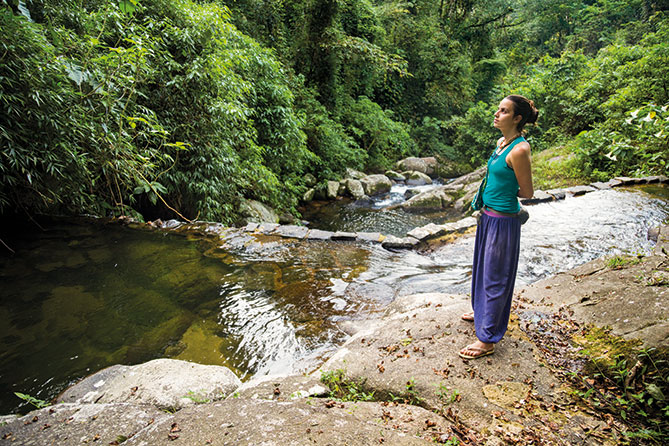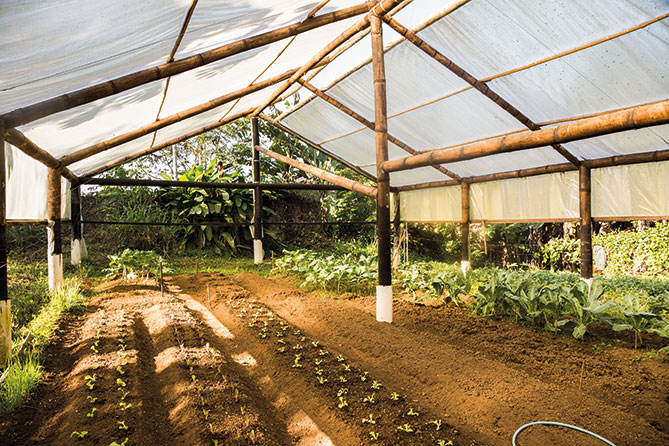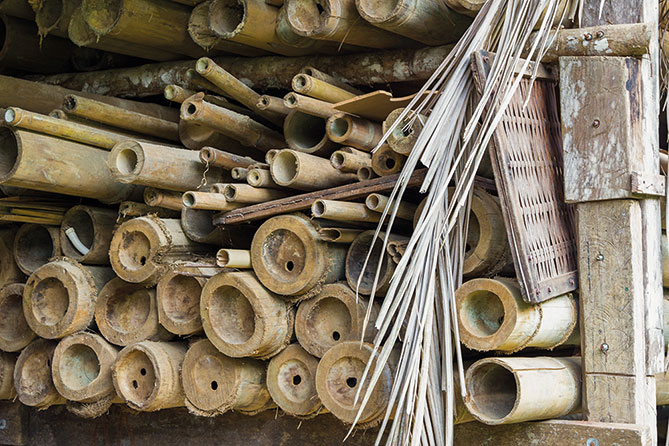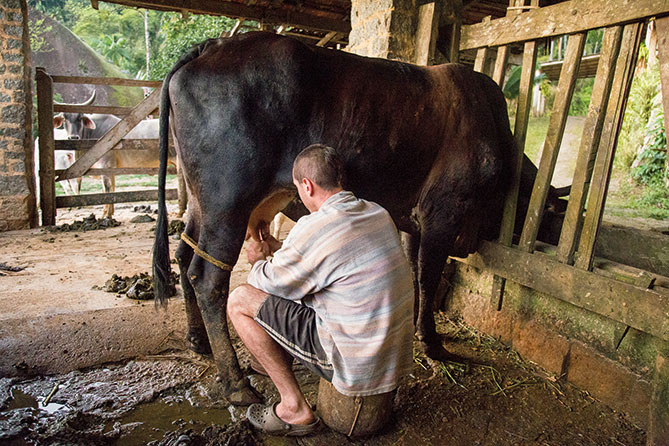Retratos Magazine
Ecovillages point out new possibilities of living together
January 29, 2019 10h00 AM | Last Updated: January 30, 2019 03h41 PM
Coliving projects, concern with the environment, organic farming and civil construction with alternative materials. “Ecovillage” is the noun by which, since the 1990's, has been coined a lifestyle that embrace all these trends together or some of them combined. In Brazil, there are more and more communities that are characterized like that - which poses new challenges for the IBGE to portray the country in the agricultural and population censuses.
National and international researchers classify ecovillages as a kind of "intentional community”. According to Maria Accioly, PhD in Social Ecology from the Federal University of Rio de Janeiro (UFRJ), intentional communities are groups that deliberately choose to build a project together: they look for land, settle down and carry out their project. “The ecovillages can be considered a specific type of intentional community, which is particularly concerned with environmental issues, but not exclusively”, says the researcher.
Gabriel Siqueira lives with his wife and kids in an ecovillage in the north of Ilhéus, Bahia, and makes of his lifestyle an object of study and work. Master in administration and an expert in the management of ecovillages, he teaches and advises on the subject. His pursuit is to answer the following question: why do persons of middle and upper social classes leave their comfort and privileges to search for another life in the rural area?
“Motivations can vary”, says Gabriel. “Many are dissatisfied with their personal lives and also, in many cases, with the system and society as a whole”. However, the “neo rural” – it is how he calls those who left their lives in the city to live in rural ecovillages – must be aware of the difficulties of the path. Gabriel considers that the adaptation to the rural world is never easy, whether because of lack of familiarity with life far from the urban centers or because of the challenges making a living in the countryside.
IBGE researcher Maria Monica O`Neill says there has been a flow of urban persons to the interior due to several reasons. “We cannot speak of an 'urban exodus', since there are no data about that. We can identify a worldly trend of choosing to live away from the urban centers, within an area of commuting length of about 2 hours to work, for instance”.
For Monica, such an analysis must be undertaken cautiously in Brazil. “Commuting and migration data from the 2020 Population Census will allow such an analysis”, she claims.







Goura-Vrindávana: sustainability and spirituality
Simple living and high thinking: that is the moto that gathers residents and visitors to the Ashram & Ecovila Goura-Vrindávana, in the city of Paraty, RJ, at the edge of the Bocaina Mountain Range. More than two-thirds of the land are covered by the woods. Among the activities developed in the ecovillage are cattle protection (animals raised to produce milk, not meat), buildings and courses of bamboo, agroecology and power generation. Almost 20 persons live there, including children, but the number varies according to the flow of voluntary workers and dos voluntários and guests of the hostel that occupies the same land though is administered separately.
What makes Goura unique is described in its own name: besides being an ecovillage, it is also an ashram, a Sanskrit word meaning spiritual refuge. The community is grounded on the Hare Krishna philosophy, a religious tradition that started in Brazil through the teachings of the Indian guru Srila Prabhupada in the 1970's and that is devoted to the Hindu deity Krishna. The Hare Krishna followers adopt principles such as the lactovegetarian diet and absolute prohibition of drugs, alcohol or cigarettes.
In the ecovillage, it is not necessary to be a follower, but the principles must be observed. That is why one has to go through an experimental period before becoming part of the community - a common practice in most intentional communities. “We have a voluntary program for residents-to-be to stay with us for some days", says Vraja Lila, biologist who lives in Goura. In that case, the person pays for their own basic expenses and dedicates a few hours per day to voluntary services. “We came up with this model searching in different ecovillages”, says Vraja Lila.
The spiritual mentor of the community is also its longest-time resident. Swami Purushatraya, as he is known, has lived in Goura for more than 20 years, interspersed with regular peregrinations to India in search for knowledge. His experience shows, in practice, the conclusion ecovillage researchers have been coming to: more than sustainability, ecovillages are concerned with a holistic perspective blending social matters and ethical principles.
“The word used in this alternative sphere is that one must have glue”, explains Swami. “So, our glue to keep people together is the interest for the spiritual practice, called ‘bhakti yoga’. People talk about sustainable development for nature without realizing that, most of the times, their lives are not sustainable. They have lost the philosophical view of life. Here we have a more adequate environment for this spiritual practice: simple living and high thinking”.
Muriquiassu, an ecovillage in construction
In the district of Muriqui, Niterói, RJ, the Muriquiassu ecovillage is a project started four years ago by the couple Wilson Dias and Eloína Pimentel. At the moment, they are building what will become the village headquarters and, for that purpose, they have rented a house beside the property and have made a call for voluntary workers. From 2016 onwards, more than a hundred voluntary workers must have collaborated to the construction.
The couple idealizes a bioconstruction project in the one-hectare terrain, half of which belongs to the Darcy Ribeiro Ecological Reserve, also in Niterói. The houses are being built mostly of non-industrialized materials, as adobe bricks, hyperadobe (earthbag), cob wall, burnt clay, fine plaster, cordwood (firewood). They grow banana trees, fruit trees, beans, ginger, yam, tomatoes, cassava, lettuce and plan to have ecological cisterns with rainwater harvesting. In addition, they have organic chicken farming and produce natural disinfectant and soap. Today, the goal is to build eight houses and the prerequisite to join the group is for everyone to follow a permaculture statute.
Wilson claims that Muriquiassu stemmed out of the intention to build an ecologic condo targeted at the general public. “But when you search for what is ecological in in the market, it is just a 'glimpse’”, he says. Studying permaculture, he let go of the original idea and was determined to collectively build all the houses with bioconstruction techniques. As a businessman, he lost the investors and partners in the project, but earned voluntary work. His wife, Eloína, reduced her activities as a lawyer to dedicate to Muriquiassu. She says permaculture is in her DNA: “This love for the soil, the plants comes from my forefathers, my father. It mesmerizes me, makes much more sense than laws practice, courtrooms, corruption”.
Changes in the profile of family farming
Eloína's memories traces back her childhood at her grandfather's house, in the farm. There they produced flour, brown sugar, panela. Their food was harvested in the fields. This life style changed when she went away to study. Living in town, she had a farm as a refuge and even lived in a Christian community for 20 years. However, because of her kids' schooling, she had to return to town.
The profile of the ecovillages is young – pregnant couples or with children, looking for a different way to raise them. On the other hand, it is theis exactly young population that has left the agricultural establishments, usually in search for better opportunities of work or professional qualification.
Among the family farmers, the difficulty is to keep the new generations has become an issue. “This trend has been around for some time now”, analyses reseacher Maria Monica O`Neill. “If rural producers are able to offer a better education for their kids, they leave and not always come back [to work with farming]”.
In this context, it is necessary to differentiate the profiles of those who for generations have made a living of family agriculture and the new arrivers to the ecovillages. According to the 2017 Census of Agriculture of the IBGE, there was more labor force aging than renewal over 2006. In the family-based agriculture, almost half of the workers are 45 to 64 years old and many are about to retire, whereas the number of workers aged up to 34 has declined.
“The average quantity of persons by establishment dropped, since the children are leaving and there is no replacement”, comments Antônio Florido, coordinator of the IBGE Census of Agriculture. “If this reduction goes on, many producers will stop their activities, because they lack labor force and resources to hire personnel”.
Ecovillages, in turn, are very different. Most of them are not based on agriculture as the main economic activity, as Maria Accioly explains. "They are generally middle-class and upper-middle-class families, with money to buy land and invest or work with other activities, even remote work. Agriculture in Brazil is extremely undervalued for the smallholder. "
See the complete article in the Retratos Magazine No 15.




















